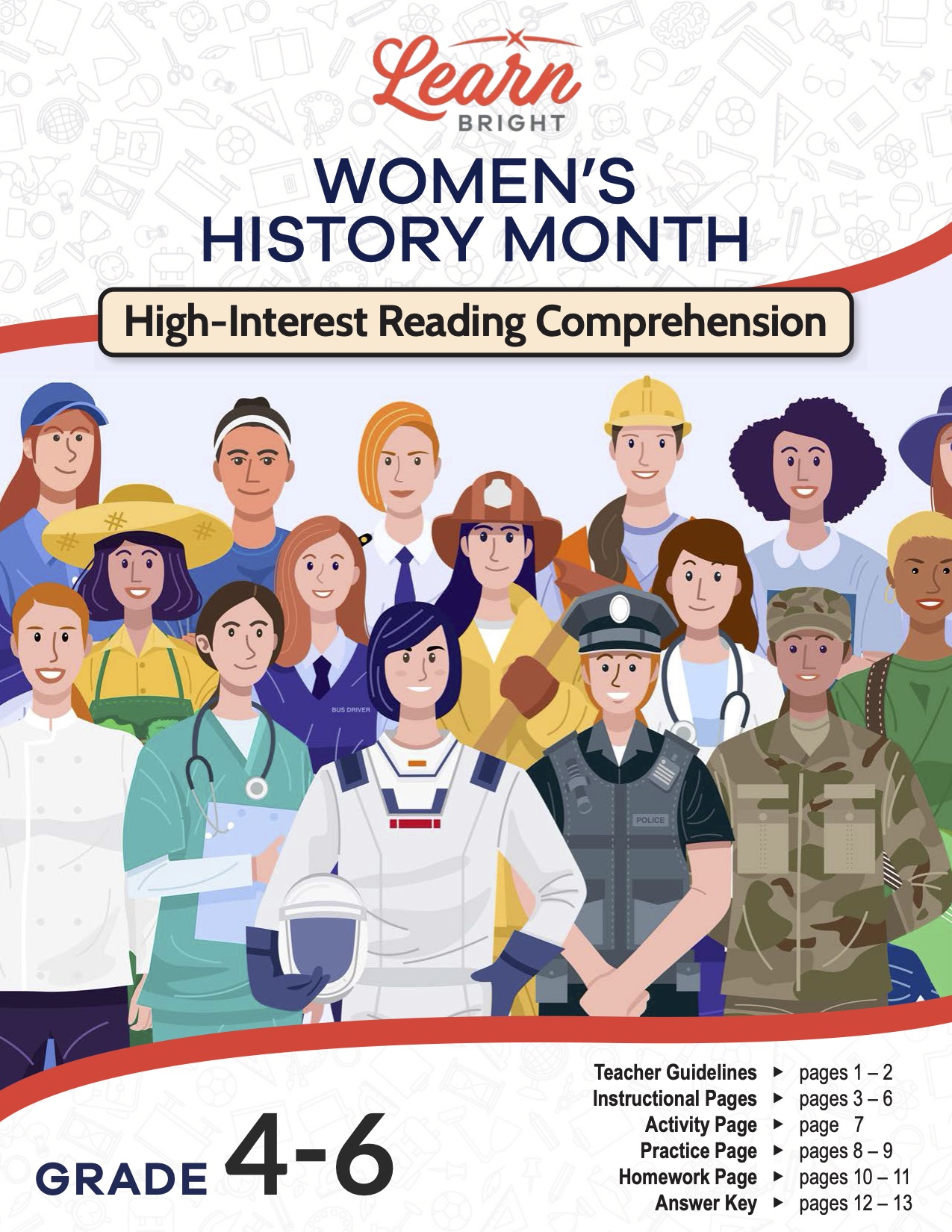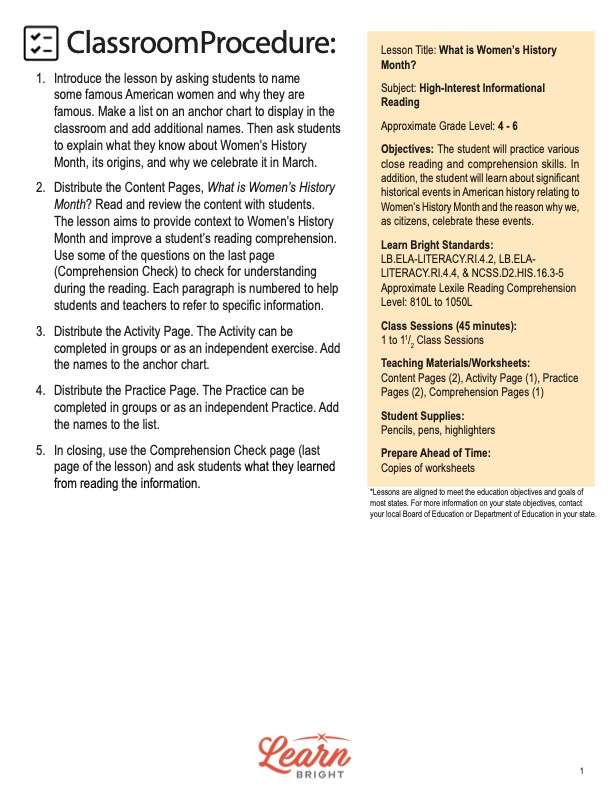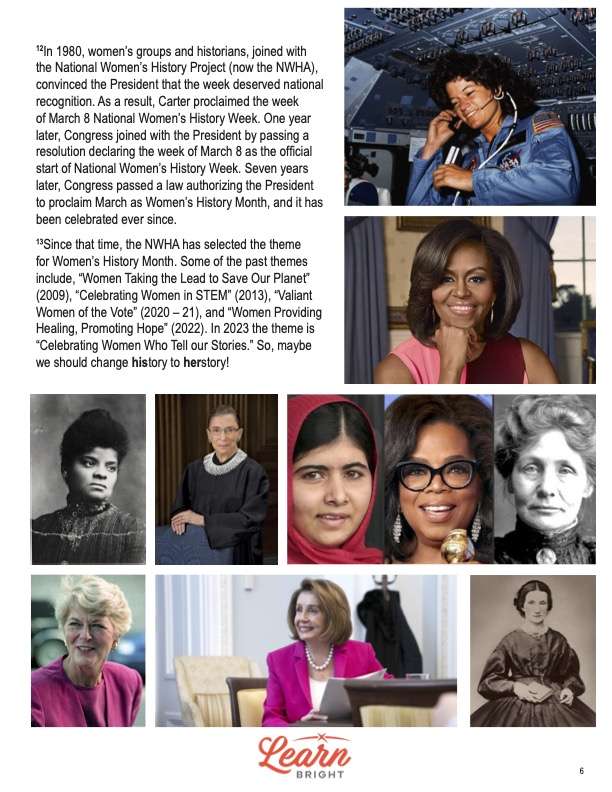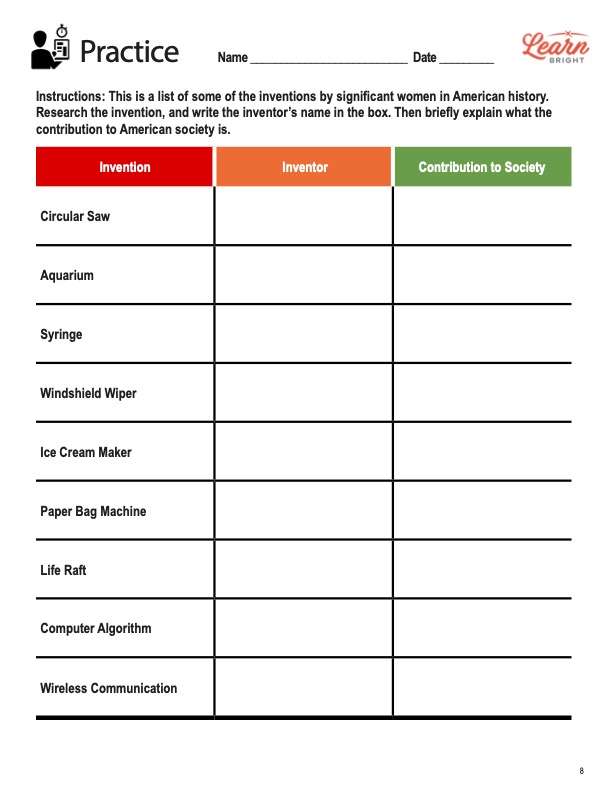Description
What our Women’s History Month lesson plan includes
Lesson Objectives and Overview: Women’s History Month introduces students to the origin of the celebration of women during the month of March. Students will discover cool facts about the lives and accomplishments of women throughout history. This lesson is for students in 4th grade, 5th grade, and 6th grade.
Classroom Procedure
Every lesson plan provides you with a classroom procedure page that outlines a step-by-step guide to follow. You do not have to follow the guide exactly. The guide helps you organize the lesson and details when to hand out worksheets. It also lists information in the yellow box that you might find useful. You will find the lesson objectives, state standards, and number of class sessions the lesson should take to complete in this area. In addition, it describes the supplies you will need as well as what and how you need to prepare beforehand.
Teacher Notes
The teacher notes page provides an extra paragraph of information to help guide the lesson and remind you what to focus on. It explains that you can teach this lesson in a whole-class setting or to an independent, small group as an activity. The blank lines on this page are available for you to write out thoughts and ideas you have as you prepare the lesson.
WOMEN’S HISTORY MONTH LESSON PLAN CONTENT PAGES
The History of His-story
The Women’s History Month lesson plan contains four pages of content. Many people don’t know that March is Women’s History Month! Every March, the President issues a proclamation, or an official and public announcement about something of great importance, declaring the month of March as Women’s History Month. Since 1978, every president has followed the tradition of naming March as the celebratory month. But unfortunately, most folks don’t know how, when, and why it started, or the importance of women in history.
Some historians wryly say the clue is in the word history—his-story! And the truth is that for much of world history, only men wrote and published stories about the past. This was because women were not treated equally to men for much of U.S. and world history. For example, in colonial America, women could not own property or vote in elections. Except for in a few places, females did not go to school. If they were at private academies, women were not taught the same subjects as men.
Men learned to read and to write Latin and studied subjects like world history and math. However, women only learned what we know as “domestic arts,” or how to manage a household. People thought that a woman didn’t need education because it was her job to work at home. Can you imagine that in modern times?
If a young girl was lucky or was from a wealthy family, she might have attended a “Dames’ School” where the local church minister was the teacher. Sometimes the minister’s wife or another local women might host a school in their home. Under the tutelage of these volunteers, young girls would learn to read and write in between learning how to manage a household. So even though women in colonial times worked side by side with the men in fields and managed the home, society did not view them as equal to men in education, politics, or business.
Why We Celebrate Women’s History Month
Now you must be thinking, this is terrible! How could people back then be so out of touch with reality and think women were not equal to men? The prevalent worldview up to the late 19th century was that women were not equal to men. This belief is called patriarchy, which is system of society or government in which men hold power and women are largely excluded.
Obviously in modern times, we have learned that women are as capable as men in any field! But, unfortunately, up to the early 20th century, the belief in the patriarchal system was widespread. So what changed, and is this why we celebrate Women’s History Month in March? Great questions! The reason we dedicate an entire month to women’s history is that women have worked tirelessly, without recognition and frequently at significant risk, to build the country we know today.
For example, you may know the names of Abigail Adams and Harriet Tubman. But have you ever heard of Eleanor Dare? In 1587, Eleanor made the arduous voyage to the Roanoke colony, England’s first colony in North America. Historians believe she gave birth to the first English child in America, Virginia. Recall in history that the Roanoke colony lasted about three years and then mysteriously disappeared. We have never found a trace of its inhabitants!
Nonetheless, many women made the trip to the new world. We know this from primary source documents like passenger lists from the early explorers. Now think for a moment—how often have you read about women journeying with the early explorers to the new world colonies? You likely haven’t, but if you know anything about the earliest settlers, you know that space on the ships was limited. Everything they brought had a purpose—including people.
Have you heard the story of Mary Chilton? She was so excited to get off the Mayflower that she jumped into the water and waded onto land. That made her the first person to set foot on Plymouth Rock. Mary would have been 12 years old at the time. You may have learned the first person was John Alden, William Bradford, or John Howland. However, some historical evidence supports that Mary was the first to touch land when the Mayflower docked offshore.
How Women’s History Month Started
All of this is to say that women played a vital role in American history as early as in the first settlements. Yet we seldom hear about their exploits, bravery, or contributions to American society in history. Thus, one reason for Women’s History Month is to learn about the influence women had on the events in American history.
The reason behind Women’s History Month is best described by the National Women’s History Alliance (NWHA). “The impact of women’s history might seem abstract to some and less pressing than the immediate struggles of working women today. But to ignore the vital role that women’s dreams and accomplishments play in our own lives would be a great mistake. We draw strength and inspiration from those who came before us—and those remarkable women working among us today. They are part of our story. A truly balanced and inclusive history recognizes how important women have always been in American society.”
So how did the movement start? Like many historical movements, a small group of people recognized a shortcoming in telling history. In March 1978, a group of educators in Santa Rosa, California, met in celebration of International Women’s Day. They realized they could do more to further the cause of women’s equality and to bring awareness to the significant contributions women have made to American history. As a result, the group extended the day to a week.
From a Week to a Month
Over several years, the movement gained popularity. In other states, it became a week-long celebration, gaining fame as Women’s History Week. Then in 1980, President Carter took notice. In 1980, women’s groups and historians joined with the National Women’s History Project (now the NWHA). They convinced the president that the week deserved national recognition. As a result, Carter proclaimed the week of March 8 National Women’s History Week.
One year later, Congress joined with the president to pass a resolution that declared the week of March 8 as the official start of National Women’s History Week. Seven years later, Congress passed a law that authorized the president to proclaim March as Women’s History Month. We have celebrated this way ever since.
Since that time, the NWHA has selected the theme for Women’s History Month. Some of the past themes include “Women Taking the Lead to Save Our Planet” (2009) and “Celebrating Women in STEM” (2013). Another was “Valiant Women of the Vote” (2020–21). In 2022, the theme was “Women Providing Healing, Promoting Hope.” And in 2023, the theme is “Celebrating Women Who Tell our Stories.”
WOMEN’S HISTORY MONTH LESSON PLAN WORKSHEETS
The Women’s History Month lesson plan includes three worksheets: an activity worksheet, a practice worksheet, and a comprehension check. These worksheets will help students demonstrate what they learned throughout the lesson and reinforce the lesson concepts. The guide on the classroom procedure page outlines when to hand out each worksheet to your students.
CONTRIBUTION TO HISTORY ACTIVITY WORKSHEET
On the activity worksheet page, there is a list of women significant to American history. Students must choose two and write a paragraph about their contribution to U.S. history. You can have students do more than two if you wish. You could also assign which women students will write about.
INVENTIONS BY WOMEN PRACTICE WORKSHEET
For the practice worksheet, students will research the inventions in the first column of the chart. They will then write down the name of the inventor and briefly explain how the invention contributes to society.
WOMEN’S HISTORY MONTH COMPREHENSION CHECK
The final worksheet is a comprehension check for students to fill out. There is a total of 10 questions or prompts to respond to. The prompt lists type of skill the question aims to test in parentheses at the end of the prompt.
Worksheet Answer Keys
At the end of the lesson plan document is an answer key for the practice worksheet and comprehension check. The correct answers are all in red to make it easier for you to compare them with students’ responses. If you choose to administer the lesson pages to your students via PDF, you will need to save a new file that omits these pages. Otherwise, you can simply print out the applicable pages and keep these as reference for yourself when grading assignments.










